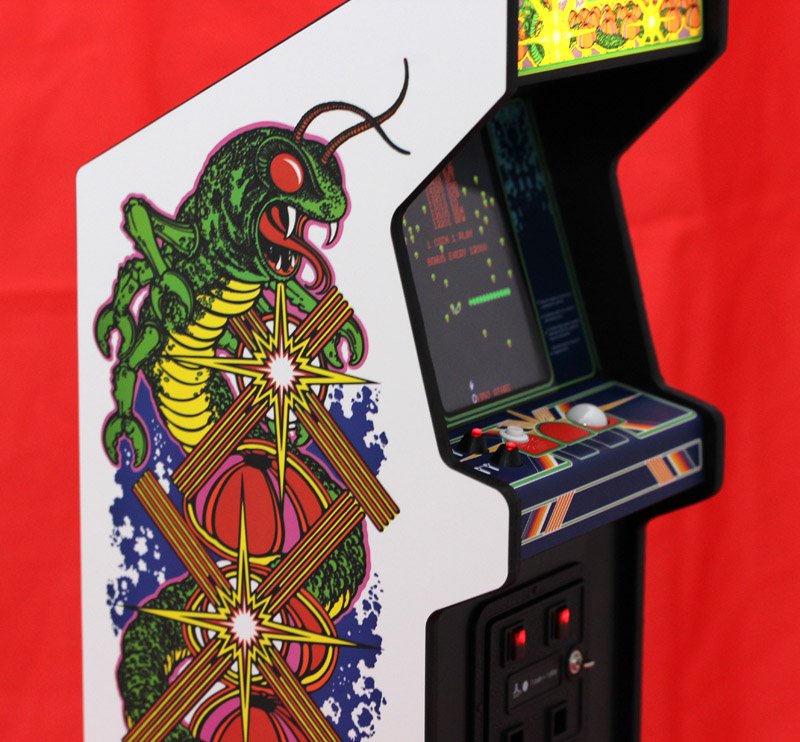Replicade Centipede combines fidelity, quality, and gosh-darned cuteness
It isn't cheap, but this take on Centipede raises the bar for mini-arcade machines.
Fans of the golden age of the American arcade—the early ’80s—certainly don't lack for options these days when it comes to revisiting those games. From mini-consoles to compilations, vintage software has practically become its own market segment. Of particular note is the recent wave of replica arcade cabinets, which attempt to recreate the individual machines that housed those games in arcades. Although far less practical (and far more space-intensive) than, say, a software compilation for PlayStation 4 or Switch, these dedicated cabinets have the advantage of being able to reproduce not only the original games, but also their control schemes. To my knowledge, you can't buy a PS4 or Switch controller that contains a trackball or spinner device, but many vintage games just aren't as fun without the control mechanism for which they were originally designed. Bespoke reproductions can recapture that play experience in a way that standardized console control pads don't.
Reproduction cabinets now come in all shapes and sizes, ranging from full-scale to keychain-friendly. The latest entrant in the faux-cabinet wars comes courtesy of New Wave Toys, which has decided to split the difference between squat, palm-sized 4" cabinets and larger products like Arcade1UP's 3/4-scale multi-cabinets. New Wave's Replicade line, which has just kicked off with a replica of Atari's Centipede, clocks in at one-sixth scale—just shy of one foot tall. New Wave Toys sent along a unit for review, and the results are genuinely impressive.

Standing about 12" tall, Replicade Centipede initially looks like some sort of extremely accurate dollhouse prop. So far, everyone who has seen it has remarked on how adorable it is, only to do a double-take when they realize it's actually a fully functioning video game as well.

Replicade Centipede is not the smallest mini-arcade cabinet on the market by any means. There are multiple lines of smaller systems that also double as working replicas. That said, the 1/6-scale format of the Replicade line feels a lot more comfortable and practical than those smaller units while looking far more accurate to the original coin-op cabinets. The super-small units I've played to date all suffer from squashed proportions (both in terms of the cabinet and the screen dimensions), whereas Replicade delivers a pleasantly faithful rendition of Centipede in all respects. Every last detail of the original unit is reproduced here, from Atar's distinctive conical player-select buttons to the way the fire button appears to be out of registration with the starburst icon beneath it. The machine's side art is also reproduced here by way of a high-quality vinyl appliqué.

Besides looking impressively like the real deal, it also boasts exceptional construction quality. That said, New Wave Toys's premium angle is reflected in the mini-cabinet's price. At $160, each Replicade costs more than half of an Arcade1UP multi-game system despite being only one-fourth the size (and containing only a single game). New Wave is teasing a total line of 10 different units altogether, but this price point seems a bit prohibitive for their format to work as a casual collectible for completists; most people will need to cherry-pick their favorites.
Still, at least there's no question that you're paying for a well-built replica here. Replicade Centipede has some heft to it despite its modest size. Its weight makes the cabinet stable during play, and the console feels like the sort of thing you can hammer at on a regular basis without fear that it will disintegrate.
Impressively, everything about the unit functions as a working replica. The cabinet marquee lights up, as do the start buttons and even the coin return lights on the cash box in the base. Speaking of the cash box, that door opens to reveal a tiny coin stash space in which you can stow the four 1/6-scale arcade tokens that ship with the system. About the only thing that doesn't function here are the coin slots themselves, which sadly don't accept the coins. That said, you do "insert credits" by pressing the light-up return buttons, which is a fun touch.

And, of course, the cabinet plays Centipede itself. The packaging touts an "official arcade ROM," though this doesn't mean the system contains a tiny perfect replica of the original arcade PCB. It's a digital Centipede ROM running on some sort of emulator with a custom front-end. By escaping to the system menu, you can adjust a handful of settings (i.e., turn off the marquee illumination), but otherwise it's essentially a small emulator computer dedicated to playing a single arcade game. One assumes the system could be hacked to add something like Millipede or Crystal Castles, but the cabinet's interface definitely limits what an enterprising hacker could do here—which is part of the appeal.

Above all else, Replicade Centipede plays an impressive game of Centipede, like it says on the box. The tiny track ball and fire button work surprisingly well at this scale, and the game looks, controls, and sounds extremely authentic. I last played an original arcade unit of Centipede about six weeks ago at Long Island Retro Expo, so my memories of the game are pretty fresh, and Replicade definitely nails it. In fact, I'd say Centipede was an ideal choice for a debut title for this line—the ball-and-button scheme scales down perfectly. New Wave has already announced a Street Fighter II Replicade, and its complex stick-and-six-button scheme seems like it's going to be considerably more challenging to make work at this scale. But Centipede? Besides its broad demographic appeal, it also shrinks down wonderfully.

All of that said, Replicade Centipede does have its shortcomings. The tiny trackball is great, but it's not perfect; it doesn't have the same free action you find in the original cabinet. That's probably an unavoidable consequence of the scale at work here. The real machine's trackball is large and dense, so when you set it spinning it has sufficient mass to keep going. The pebble-sized ball embedded in the Replicade probably weighs only a few grams, so it's simply a matter of physics that it stalls out more quickly. This is not a game-breaking issue—even an imperfect trackball is a better way to play Centipede than a joystick or keyboard—but fans of the game will definitely notice.
The other big shortcoming here is probably equally unavoidable. The screen New Wave used for this mini-cabinet doesn't quite do the trick. The visual proportions are correct, the colors are accurate and bright, and there's no LCD ghosting; however, the resolution is wrong. Rather than using a screen with a 240x256-pixel resolution (or an even multiple thereof), the Replicade includes a screen whose pixel dimensions result in a fair amount of distortion. True, the graphics are very tiny here, but that's part of the problem—extremely fine details, such as score indicators, stretch and blur to the point that they can become difficult to read. If the Replicade included a screen with the pixel density of a phone screen, this wouldn't be an issue, but the combination of incorrect scaling and low pixel-density doesn't do Centipede's stark visuals any favors. In a more detailed game (say, Street Fighter II), this probably won't even matter, but Centipede's crisp colors on pure black definitely draw attention to it. Realistically, New Wave Toys was undoubtedly constrained by the screens available for wholesale purchase on the market, and no one manufactures true-resolution LCDs for arcade replicas, but it's unfortunate regardless.


And finally, one other complaint: Battery life. The Replicade comes with a built-in rechargeable battery, but either that battery is tiny or the special effects are incredibly power-hungry, because I only get about 30 minutes of use out of a full charge. The unit can run on A/C power with the included micro-USB cable, but even so I'm surprised at how brief the battery life is on this thing given that the mini-cabinet's total volume shouldn't make battery size an issue the way it is for a truly compact device like a phone or handheld game console.

These three complaints are, in the end, fairly minor issues. They don't significantly diminish from the appeal and joy of this shrunken-down cabinet. Replicade Centipede has a great form factor loaded with accurate, nostalgic details, it plays a pretty solid rendition of an arcade classic, and it's built remarkably well. While the price and its small technical compromises keep it from being a truly perfect miniature edition of Centipede for everyone, I feel like the Replicade approach offers the best balance of practical factors for this particular niche of classic gaming. It's big enough to be both playable and a faithful reproduction (rather than a clumsy approximation), while at the same time it doesn't have a massive footprint that demands its own corner of a room the way larger cabinets do. Depending on what the unannounced lineup of future releases holds, I could certainly see myself grabbing a few more Replicade versions of old favorites down the line.




